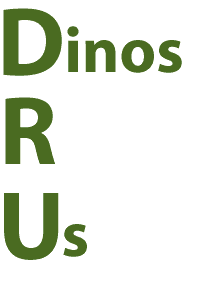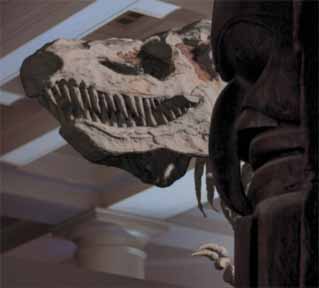|
I call the dinosaur "the" totem animal of modernity because it is unique, sui generis. The modern world has many symbolic animals and many monsters, but none function in precisely the way dinosaurs do. The word "totem," as Claude Levi-Strauss reminds us, "is taken from the Ojibwa, an Algonquin language of the region to the north of the Great Lakes of northern America. The expression ototeman...means roughly, 'he is a relative of mine.'" The totem (which is generally an animal, but can also be a plant, mineral, or even an artificial object) is thus a social symbol, a sign of the clan or collectivity.
In traditional, pre-modern societies, totem animals played four basic roles. They served as symbols of the social unit (tribe, clan, or nation) and as ancestor figures reminding the clan of its ancient origin and descent. They also served both as "taboo" and ritual objects. The dinosaur plays all four of these roles, albeit in modified ways, in modern societies. The dinosaur is a "clan sign" for a wide range of social collectivities, from national to federal states, from vanishing races to dominant, imperial civilizations, from warrior-hunter brotherhoods to dangerous new sisterhoods of "clever girls."
The dinosaurís ancestral function is relatively straightforward. In the master
narrative of modern paleontology, the Age of Reptiles precedes and makes way for the Age of Mammals. Dinosaurs are the rulers of the earth before mankind; they must die out so that we can live; they must disappear or devolve into degenerate "creeping things" (or relatively harmless birds) so that we can appear and evolve into the world-dominant species. Their relation to human beings is rather like that of the Chthonian (often reptilian) gods of the underworld in Greek mythology, the "giants of the earth" who must be killed or imprisoned so that humanoid sky-gods, the Olympians, can assume dominance. This ancestral narrative is replayed, moreover, at the individual level in childrenís identification of their parents as dangerous dinosaurial giants who (fortunately) will inevitably make room for their offspring by becoming extinct.
The most complex feature of the dinosaur totem is the cluster of taboos and rituals that surround its excavation and display. This is the core of public dinosaur fascination and "dinomania," the set of emotional and intellectual associations that give dinosaurs "magic" and "aura" in mass culture. While the traditional totem was generally a living, actually existing animal that had an immediate, familiar relation to its clan, the dinosaur is a rare, exotic, and extinct animal that has to be "brought back to life" in representations, and then domesticated, made harmless and familiar. The traditional totem located power and agency in nature: Totem animals and plants bring human beings to life and provide the natural basis for their social classifications. The modern totem locates power in the human: We classify the dinosaurs and identify ourselves with them; we bring the dangerous monsters back to life in order to subdue them.
If the traditional totem animal was not to be killed, or to be killed and eaten only under special ritual conditions, the dinosaur is an animal that cannot be killed (being already dead), but must be brought back to life so that it can be consumed as public spectacle. More generally, the dinosaur is generally figured as itself a massive eating machine, providing a spectacle of rapacious consumption that becomes more fascinating the closer the meal comes to including one of our own species as the main course.
We might be tempted to say that the traditional totem is religious and magical, an object of superstitious reverence and animistic thinking, while the modern totem enjoys the authority and prestige of science. This makes sense insofar as science plays the role of a modern, secular religion, popularly misconceived as the final arbiter of truth and reality in all matters. This sort of "scientism" or scientific ideology needs to be distinguished, however, from the actual practice of science, which tends to be skeptical, provisional, and modest about the extent and durability of its truth claims.
Traditional totems, similarly, are probably not as dogmatically religious or
magical in their authority as early anthropologists thought. The notion of a radical distinction between the "savage" and "modern" mind is precisely what totemism tends to undermine. Traditional totem animals and plants may, in fact, have as much to do with ethnozoology and ethnobotany-traditional bodies of natural lore based in accumulated observations and experiments passed on over many generations-as with any magical or religious symbolism.
An essential part of the taboo (in the sense of aura or magic) of the dinosaur resides in its status as a scientific object, more specifically, its role as a monument to "Big Science," and even more aptly to what might be called "pure scientism." The dinosaur exemplifies pure science because it is useless and impractical, and yet it provides a highly visible speculative object in which areas of uncertainty and controversy are very broad.
"The" dinosaur is so speculative, in fact, that it may never have existed as a natural kind or a coherent scientific concept, but only as a name that survives because of its popular appeal. An umbrella term for two distinct orders of animals (the Ornithischia and Saurischia), "dinosaur" has always designated a monstrous hybrid. It is not surprising then that its cultural totemic status is marked by taboo and ambivalence. The dinosaur is monument and toy; monstrous and silly; pure, disinterested science and vulgar, fraudulent commercialism.
Thus, the taboos (in the sense of prohibitions) surrounding the dinosaur tend to manifest themselves as efforts to deny or overcome this ambivalence by declaring the dinosaur to be purely a scientific object, a serious and real object untainted by magic, money, or "cultural" interest. Stephen Jay Gould's anxiety that the authentic dinosaur will be destroyed by the "deluge" of commerce and vulgar publicity is an expression of this taboo. The truth is that the dinosaur is never really separable from its popular and cultural status; the flood of publicity that seems to threaten its existence is the very thing that keeps it alive. |

